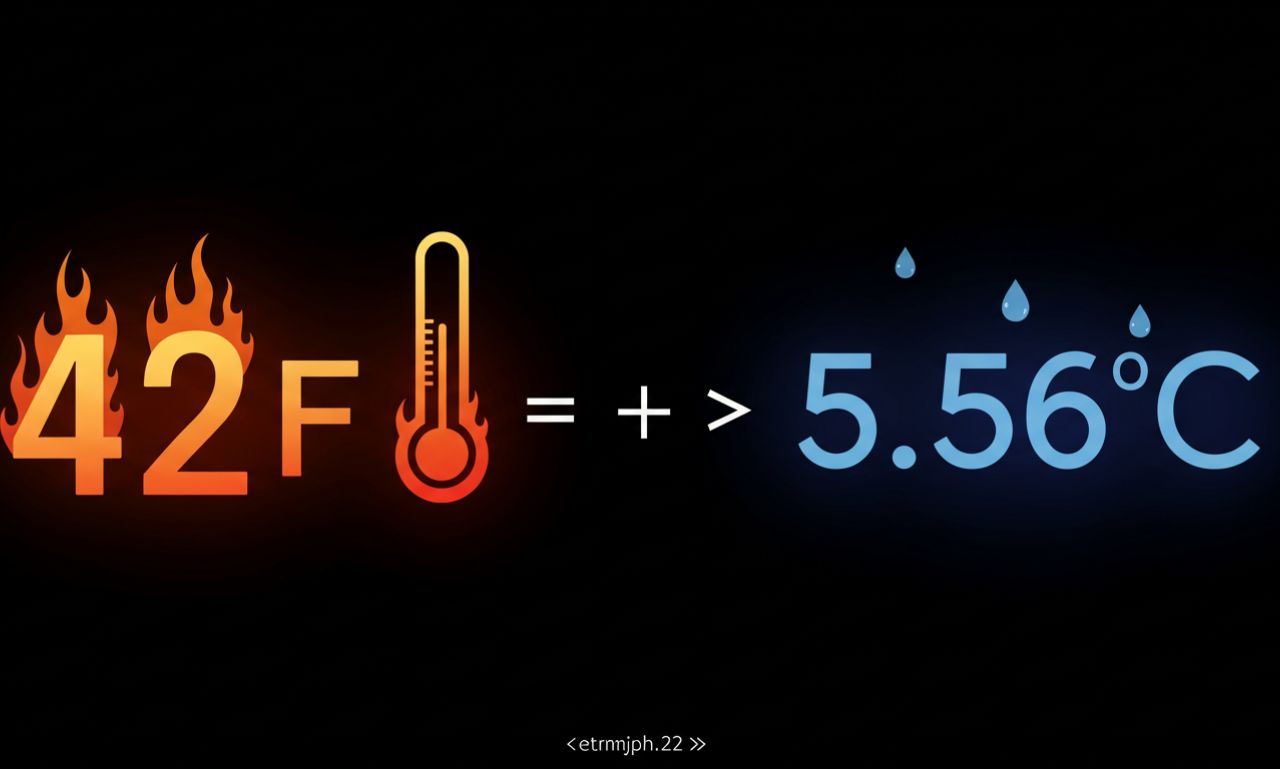Temperature is one of the most commonly measured quantities in both daily life and scientific settings. While some countries use Fahrenheit (°F), others prefer Celsius (°C). Understanding how to convert between the two is a useful skill, especially when traveling, cooking, or working with international data. So what does 42 F in C mean? It simply refers to the conversion of 42 degrees Fahrenheit to Celsius.
In this article, we’ll explore the method behind this temperature conversion, the difference between the two scales, and the real-world significance of 42°F in various contexts.
Understanding Fahrenheit and Celsius Scales
Before converting 42 F in C, it’s helpful to understand the basics of each temperature scale:
-
Fahrenheit (°F): Primarily used in the United States and a few other countries, the Fahrenheit scale sets 32°F as the freezing point of water and 212°F as the boiling point.
-
Celsius (°C): Used by most of the world, Celsius sets 0°C as the freezing point and 100°C as the boiling point of water. It’s part of the metric system and commonly used in scientific research and education.
Knowing how each scale works provides context for why accurate temperature conversion is important in everything from weather forecasting to cooking and healthcare.
How to Convert 42 F in C
To convert 42 degrees Fahrenheit to Celsius, you can use the following formula:
Now, let’s apply the formula to convert 42 F in C:
So, 42°F is approximately 5.56°C.
Real-Life Context: What Does 42°F Feel Like?
Now that we know 42 F in C is about 5.56°C, it’s useful to understand how that feels in real-world terms.
-
Weather: In both Fahrenheit and Celsius, this temperature is considered chilly or cool. You’ll likely need a jacket or light sweater if you’re going outside.
-
Indoor Climate: Most indoor heating systems aim for temperatures between 68°F (20°C) and 72°F (22°C). So, 42°F (5.56°C) would feel quite cold indoors.
-
Gardening and Agriculture: Temperatures around 42°F can signal frost risk for certain plants, especially if it dips lower during the night.
-
Health Considerations: Exposure to this temperature without proper clothing can lead to cold stress, particularly for young children or the elderly.
Why Converting 42 F in C Matters
Accurate temperature conversion isn’t just for trivia—it has practical uses in many areas of life:
-
International Travel: If you’re visiting a country that uses Celsius, knowing how to convert Fahrenheit temperatures (like 42°F) can help you dress appropriately or plan outdoor activities.
-
Cooking: Some recipes list oven temperatures in Fahrenheit, while others use Celsius. A mistake in conversion could result in overcooked or undercooked food.
-
Scientific Work: Scientists often use Celsius for experiments and data logging. Understanding conversions ensures accurate data sharing and interpretation.
-
Medical Use: Thermometers in different countries may display readings in either scale. Knowing what 42°F means in Celsius helps avoid misinterpretations in medical records or temperature-related diagnoses.
Quick Reference Table for Other Conversions
Here’s a quick reference table to help you understand Fahrenheit to Celsius conversions near the 42°F mark:
| Fahrenheit (°F) | Celsius (°C) |
|---|---|
| 40°F | 4.44°C |
| 42°F | 5.56°C |
| 45°F | 7.22°C |
| 50°F | 10.00°C |
| 55°F | 12.78°C |
This table shows that 42°F sits in a temperature range that is moderately cold and commonly experienced in early spring or late fall.
Tips for Quick Temperature Conversion
If you find yourself needing to convert temperatures frequently, here are some tips to help:
-
Memorize Key Benchmarks:
-
32°F = 0°C (freezing point of water)
-
98.6°F = 37°C (average human body temperature)
-
212°F = 100°C (boiling point of water)
-
-
Use Estimations:
-
To quickly estimate F to C, subtract 30 and divide by 2 (works well for general weather conditions).
-
Example: (42 – 30) / 2 = 6°C (rough estimate, actual is 5.56°C)
-
-
-
Use Online Tools:
-
Many websites and smartphone apps allow instant conversions. Just search “42 F in C” and you’ll get an immediate answer.
-
Common Misconceptions About Fahrenheit and Celsius
-
They’re Interchangeable: Many assume temperatures like 42°F and 42°C are similar. In reality, 42°C is dangerously hot, while 42°F is quite cold.
-
One is More Accurate: Both scales are accurate, but Celsius is more scientific, while Fahrenheit is better suited for daily comfort ranges like weather reporting.
Understanding these differences ensures better decisions, especially when dealing with international settings or scientific data.
Conclusion: The Importance of Understanding 42 F in C
Converting 42 F in C may seem like a small detail, but it has meaningful implications in everyday life, science, travel, and even cooking. With 42°F equaling approximately 5.56°C, we now understand how to calculate and interpret temperatures between these two widely used systems.
As our world becomes more global and interconnected, knowing how to convert temperatures like 42 F in C equips you with the knowledge to communicate clearly, prepare adequately, and avoid costly or uncomfortable mistakes.











